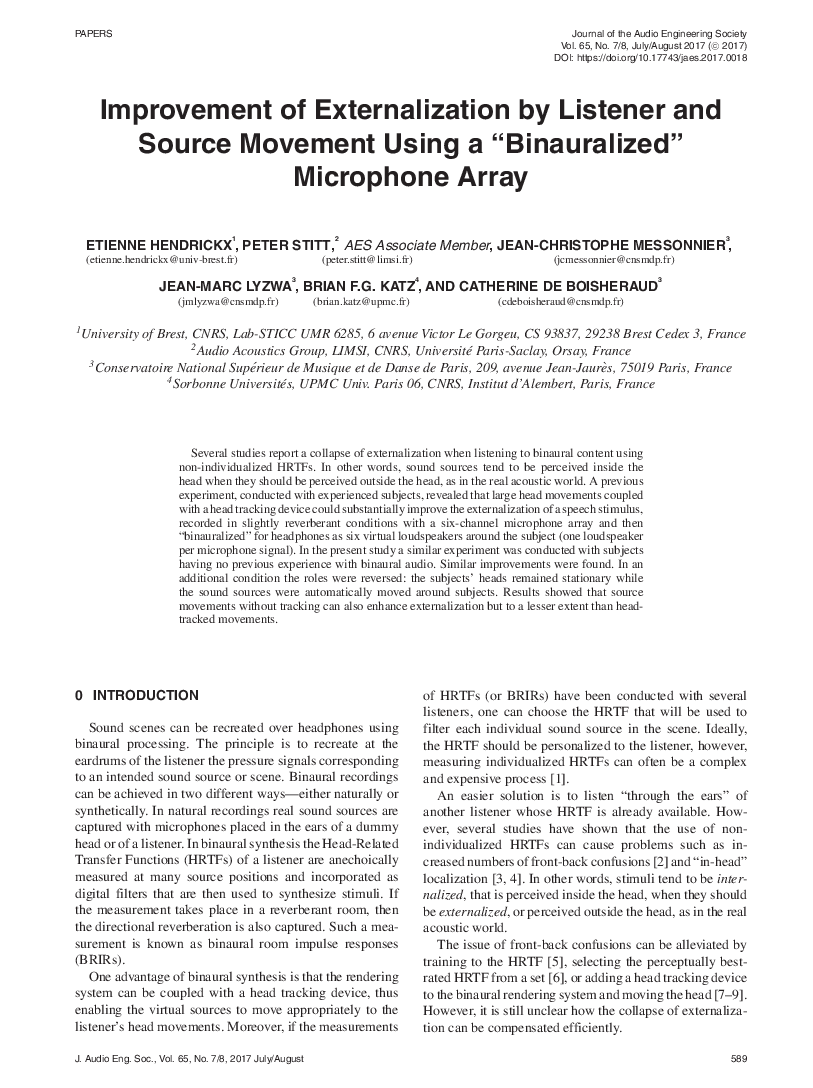Home / Publications / E-library page
You are currently logged in as an
Institutional Subscriber.
If you would like to logout,
please click on the button below.
Home / Publications / E-library page
Only AES members and Institutional Journal Subscribers can download
Several studies have reported a collapse of externalization (source location is perceived as being inside the head) when listening to binaural content with nonindividualized HRTFs. A previous experiment conducted with experienced subjects revealed that large head movements coupled with a head-tracking device could substantially improve the externalization of a speech stimulus. In the present study, a similar experiment was conducted with subjects having no previous experience with binaural audio. Similar improvements were found. In an additional condition, the roles were reversed: the subjects’ heads remained stationary while the sound sources were automatically moved around subjects. Results showed that source movements without tracking can also enhance externalization, but to a lesser extent than head-tracked movements. The speech stimulus was a male voice recorded in slightly reverberant conditions with a six-channel microphone array and then “binauralized” over headphones by simulating six virtual loudspeakers around the subject using several nonindividualized HRTFs. It was presented with two different orientations: 0° and 180°
Author (s): Hendrickx, Etienne; Stitt, Peter; Messonnier, Jean-Christophe; Lyzwa, Jean-Marc; Katz, Brian F.G.; de Boishéraud, Catherine
Affiliation:
University of Brest, CNRS, Brest Cedex 3, France; Audio Acoustics Group, LIMSI, CNRS, Université Paris-Saclay, Orsay, France; Conservatoire National Supérieur de Musique et de Danse de Paris, Paris, France; Sorbonne Universités, CNRS, Institut d`Alembert, Paris, France
(See document for exact affiliation information.)
Publication Date:
2017-07-06
Import into BibTeX
Permalink: https://aes2.org/publications/elibrary-page/?id=19174
(262KB)
Click to purchase paper as a non-member or login as an AES member. If your company or school subscribes to the E-Library then switch to the institutional version. If you are not an AES member Join the AES. If you need to check your member status, login to the Member Portal.

Hendrickx, Etienne; Stitt, Peter; Messonnier, Jean-Christophe; Lyzwa, Jean-Marc; Katz, Brian F.G.; de Boishéraud, Catherine; 2017; Improvement of Externalization by Listener and Source Movement Using a “Binauralized” Microphone Array [PDF]; University of Brest, CNRS, Brest Cedex 3, France; Audio Acoustics Group, LIMSI, CNRS, Université Paris-Saclay, Orsay, France; Conservatoire National Supérieur de Musique et de Danse de Paris, Paris, France; Sorbonne Universités, CNRS, Institut d`Alembert, Paris, France; Paper ; Available from: https://aes2.org/publications/elibrary-page/?id=19174
Hendrickx, Etienne; Stitt, Peter; Messonnier, Jean-Christophe; Lyzwa, Jean-Marc; Katz, Brian F.G.; de Boishéraud, Catherine; Improvement of Externalization by Listener and Source Movement Using a “Binauralized” Microphone Array [PDF]; University of Brest, CNRS, Brest Cedex 3, France; Audio Acoustics Group, LIMSI, CNRS, Université Paris-Saclay, Orsay, France; Conservatoire National Supérieur de Musique et de Danse de Paris, Paris, France; Sorbonne Universités, CNRS, Institut d`Alembert, Paris, France; Paper ; 2017 Available: https://aes2.org/publications/elibrary-page/?id=19174
@article{hendrickx2017improvement,
author={hendrickx etienne and stitt peter and messonnier jean-christophe and lyzwa jean-marc and katz brian f.g. and de boishéraud catherine},
journal={journal of the audio engineering society},
title={improvement of externalization by listener and source movement using a “binauralized” microphone array},
year={2017},
volume={65},
issue={7/8},
pages={589-599},
month={july},}
TY – paper
TI – Improvement of Externalization by Listener and Source Movement Using a “Binauralized” Microphone Array
SP – 589 EP – 599
AU – Hendrickx, Etienne
AU – Stitt, Peter
AU – Messonnier, Jean-Christophe
AU – Lyzwa, Jean-Marc
AU – Katz, Brian F.G.
AU – de Boishéraud, Catherine
PY – 2017
JO – Journal of the Audio Engineering Society
VO – 65
IS – 7/8
Y1 – July 2017